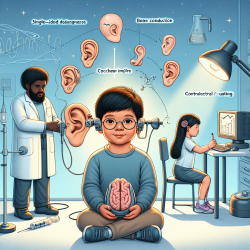As practitioners in the field of speech-language pathology, we constantly seek evidence-based strategies to enhance the auditory outcomes and overall quality of life for children with hearing impairments. A recent comprehensive review titled Single-Sided Deafness and Hearing Rehabilitation Modalities: Contralateral Routing of Signal Devices, Bone Conduction Devices, and Cochlear Implants provides valuable insights into the management of single-sided deafness (SSD) and offers guidance on selecting appropriate rehabilitation modalities.
SSD is characterized by severe to profound sensorineural hearing loss in one ear while the other ear maintains normal or near-normal hearing. This condition adversely affects sound localization, speech comprehension in noisy environments, and spatial awareness, ultimately impacting the quality of life (QoL) for affected individuals.
Key Rehabilitation Modalities for SSD
- Contralateral Routing of Signal (CROS) Devices: These non-surgical devices reroute auditory signals from the impaired ear to the functioning ear, mitigating the head shadow effect and improving sound awareness. However, they do not restore binaural hearing, and challenges remain in noisy environments.
- Bone Conduction Devices (BCD): BCDs transmit sound via bone conduction to the better ear, bypassing the air conduction pathway. They can be surgically implanted or worn externally. While they improve sound awareness, they also do not restore binaural hearing.
- Cochlear Implants (CI): CI is the only intervention that can restore binaural hearing. It significantly enhances speech perception, spatial localization, and overall QoL. Early implantation, especially in children, is crucial to leverage neuroplasticity and optimize outcomes.
Implications for Practitioners
The review underscores the importance of comprehensive preoperative counseling, which should include:
- Discussion of alternative technologies
- Implications of no treatment
- Realistic expectations
- Importance of auditory training
By integrating these elements into practice, practitioners can better support families in making informed decisions and enhance therapeutic outcomes.
Encouraging Further Research
While the review provides a robust foundation, it also highlights gaps in current knowledge, particularly in standardizing outcome domains and measurement tools. Practitioners are encouraged to contribute to ongoing research efforts to establish a unified framework for assessing SSD treatments. This will facilitate high-quality studies and enable more precise comparisons of different interventions.
To read the original research paper, please follow this link: Single-Sided Deafness and Hearing Rehabilitation Modalities: Contralateral Routing of Signal Devices, Bone Conduction Devices, and Cochlear Implants.










